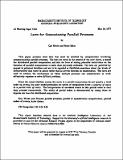Laws for Communicating Parallel Processes
Author(s)
Baker, Henry; Hewitt, Carl
DownloadMain article (942.5Kb)
Metadata
Show full item recordAbstract
This paper presents some laws that must be satisfied by computations involving communicating parallel processes. The laws are stated in the context of the actor theory, a model for distributed parallel computation, and take the form of stating plausible restrictions on the histories of parallel computations to make them physically realizable. The laws are justified by appeal to physical intuition and are to be regarded as falsifiable assertions about the kinds of computations that occur in nature rather than as proven theorems in mathematics. The laws are used to analyze the mechanisms by which multiple processes can communicate to work effectively together to solve difficult problems.
Since the causal relations among the events in a parallel computation do not specify a total order on events, the actor model generalizes the notion of computation from a sequence of states to a partial order of events. The interpretation of unordered events in this partial order is that they proceed concurrently. The utility of partial orders is demonstrated by using them to express our laws for distributed computation.
Description
Key Words and Phrases: parallel processes, parallel or asynchronous computations, partial orders of events, Actor theory.
CR Categories: 5.21, 5.24, 5.26.
This report describes research done at the Artificial Intelligence Laboratory of the Massachusetts Institute of Technology. Support for the laboratory's artificial intelligence research is provided in part by the Advanced Research Projects Agency of the Department of Defense under Office of Naval Research contract N00014-75-C-0522.
Date issued
1977-05-10Publisher
MIT Artificial Intelligence Laboratory
Series/Report no.
MIT Artificial Intelligence Laboratory Working Papers, WP-134A;
Keywords
Actor theory, partial orders of events, parallel or asynchronous computations, parallel processes